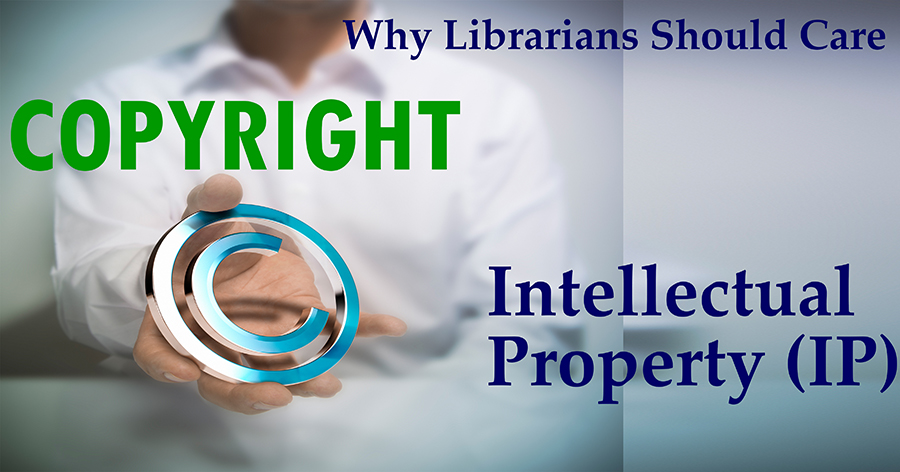By Marcus Durand on Friday, November, 2nd, 2018 in Blog Posts,Blog: Library Management & Research (LIB),Latest Updates. No Comments
This piece is the final installment of a four-part series called “Why Should Librarians Care about Intellectual Property (IP)?” See links to the previous Parts 1, 2, & 3 below, at the base of this post.

This final post on why librarians should care about intellectual property (IP) will take a closer look at the form of IP that most librarians will deal with on a daily basis: copyright. Academic, public, and law librarians may occasionally come across questions about other forms of IP, like patents, trademarks, and designs, but copyright issues are ingrained in a librarian’s everyday tasks. A librarian will need to consider copyright every time they order a document over interlibrary loan or when they instruct a patron on how they can share and use a publication obtained through the library.
What is Copyright?
The U.S. Copyright Office defines copyright as “a form of protection provided by the laws of the United States for ‘original works of authorship’, including literary, dramatic, musical, architectural, cartographic, choreographic, pantomimic, pictorial, graphic, sculptural, and audiovisual creations.” Copyright law is complex and can’t be summarized easily in a single blog post, but librarians can learn more about U.S. copyright policies and key concepts through the circulars available from the U.S. Copyright Office website.
Other important copyright concepts that librarians should be familiar with include:
• Fair Use: The U.S. Copyright Office defines fair use as “a legal doctrine that promotes freedom of expression by permitting the unlicensed use of copyright-protected works in certain circumstances.” Examples of activities that may qualify as fair use include “criticism, comment, news reporting, teaching, scholarship, and research.”
• Public Domain: According to the U.S. Copyright Office, a work is in the public domain if “if it is no longer under copyright protection or if it failed to meet the requirements for copyright protection. Works in the public domain may be used freely without the permission of the former copyright owner.”
• Creative Commons Licenses: Creative Commons copyright licenses are an alternative licensing structure with easily understandable licensing terms and usage rights.
Why should librarians care about Copyright?
Most resources in any library collection, ranging from books and journal articles to audiovisual creations and artwork, will be covered by some form of copyright protection. Librarians are responsible for ensuring that patrons and library staff follow copyright law when using and sharing library materials. Just as a few examples:
• Librarians may need to manage Annual Copyright Licenses through the Copyright Clearance Center for their institutions, in order to allow sharing of copyright-covered materials among researchers or faculty.
• Librarians are often responsible for tracking publication usage and paying copyright fees related to interlibrary loans. See the Interlibrary Loan section of Copyright Crash Course from University of Texas Libraries to learn more about copyright guidelines for interlibrary loans.
• Librarians may provide training to patrons about proper usage of copyright-covered materials for presentations and research purposes.
Librarians may also be asked to figure out whether a work is still under copyright protection, which can require a check of U.S. copyright registration and renewal records.
How can I find Copyright Information?
Here are a few key resources that librarians can use to find copyright information, materials available for re-use through Creative Commons licenses, and large public domain collections:
• U.S. Copyright Office: Check Copyright.gov to find printable guides called circulars that educate readers about important U.S. copyright concepts and polices. Search for U.S. copyright registration and renewal information through the U.S. Copyright Public Catalog (for records 1978 to present). For pre-1978 copyright records, you can search the Copyright Card Catalog in the Copyright Public Records Reading Room at the Library of Congress in Washington D.C., or try browsing the Virtual Card Catalog (still in “proof of concept” phase).
• ALA Copyright for Libraries: Check this LibGuide from the American Library Association for a helpful collection of links to ALA resources related to copyright, fair use resources, information about “first sale” doctrine, copyright guidance related to videos and movies, resources related to the TEACH Act, and other special topics related to copyright in libraries.
• Creative Commons Search: Search across Flickr, Google Images, YouTube, and other important online media collections to find content that can be used “for commercial purposes” or to “modify, adapt, or build upon.” The search site does note that “you should always verify that the work is actually under a CC license by following the link.”
• Public Domain Collections: Find images and media in the public domain through Public Domain Collections from New York Public Library and Free to Use and Reuse Sets from the Library of Congress.
Librarians need to be the copyright experts at their institution, in order to help patrons comply with copyright law when using library resources. Expert help is also available from Cadence Group for finding copyright information and guidance on copyright best practices.
This piece is the final installment of a four-part series “Why Should Librarians Care about Intellectual Property (IP)?” See part 1 of this series: Focus on Patents
See part 2 of this series: Focus on Trademarks
See part 3 of this series: Focus on Designs
For more information, check out Cadence Group’s Library Management & Research Practice Page.
Follow us on Twitter @CadenceGroup for updates and other Cadence Group news.
